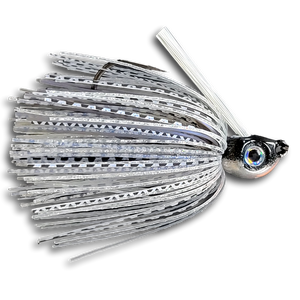Brush jigs are specialized jigs designed for fishing in heavy cover. Their tapered heads allow them to slip through tight spaces, such as brush piles, grass mats, and submerged timber, without snagging. Equipped with a stiff weed guard and heavy-duty hook, brush jigs are engineered for toughness and precision in challenging environments.
The skirt on a brush jig adds lifelike movement, while a carefully chosen trailer enhances its appeal. Whether you’re flipping into thick vegetation or working your way through a dense brush pile, brush jigs excel at drawing strikes from bass lurking in hard-to-reach places.
Brush jigs are versatile but are best known for their ability to handle heavy cover. Here are the most effective ways to fish them:
Flipping and Pitching: The primary use for brush jigs is flipping or pitching them into thick cover. Let the jig sink to the bottom, then use subtle hops or shakes to mimic a crawfish or baitfish. The weed guard ensures the jig stays snag-free, while the heavy-duty hook provides secure hooksets.
Dragging: In areas with less dense cover, brush jigs can be dragged along the bottom. The tapered head helps them navigate rocky or uneven terrain, and the skirt and trailer provide lifelike movement to entice strikes.
Skipping: Brush jigs are excellent for skipping under docks, overhanging trees, or tight spaces where bass are likely to hide. The compact design and streamlined head make skipping easy and accurate.
Punching Through Mats: With the addition of a heavier weight, brush jigs can be used to punch through thick grass mats or other surface vegetation. This technique targets bass holding below the cover.
Brush jigs shine in heavy cover and structure-rich environments, but they can be effective in a variety of conditions:
- Spring: Flip or pitch brush jigs into shallow cover like brush piles, grass edges, or flooded timber where bass are staging for the spawn.
- Summer: As bass move deeper, target submerged brush piles, grass lines, or timber near drop-offs and ledges. Dragging a brush jig through deeper cover can be particularly effective.
- Fall: Brush jigs mimic crawfish and baitfish as bass feed aggressively. Focus on shallow cover like laydowns, docks, and riprap.
- Winter: In cold water, slow down your presentation and fish brush jigs near deep brush piles or rocky points. Downsizing your jig and trailer can help tempt lethargic bass.
Brush jigs are most effective in lakes, reservoirs, and rivers with abundant cover, such as vegetation, submerged wood, or rocky terrain.
Best Colors and Trailers for Brush Jigs
Color selection for brush jigs should match the water clarity and forage in your fishing area:
- Clear Water: Natural colors like green pumpkin, watermelon, and brown are ideal for imitating crawfish or baitfish.
- Stained or Murky Water: Brighter or high-contrast colors like black and blue, chartreuse, or white help fish locate your jig.
- Low-Light Conditions: Darker colors like black or purple create a strong silhouette for better visibility.
Pairing your brush jig with the right trailer enhances its action and effectiveness:
- Craw Trailers: These are the most popular choice, adding lifelike claw movements that mimic crawfish.
- Chunk Trailers: Ideal for creating a bulkier profile, especially in cooler water.
- Swimbait Trailers: Add a swimming motion when dragging or skipping jigs near open water or vegetation.
- Creature Trailers: Perfect for flipping into dense cover, offering extra movement and bulk.
Why Brush Jigs Are So Effective
Brush jigs are a favorite among anglers for their ability to navigate heavy cover and draw strikes from bass hiding in hard-to-reach places. The tapered head design and weed guard make them virtually snag-proof, while the skirt and trailer create lifelike movement that triggers both feeding and reaction strikes.
Their versatility allows anglers to adapt to different fishing scenarios, from flipping into dense vegetation to dragging along rocky bottoms. With brush jigs, you can confidently fish in areas where other lures would struggle.
Tips for Fishing Brush Jigs
- Gear Up for the Job: Use a heavy-action rod with braided or fluorocarbon line (20-50 lb test) to handle the weight of the jig and the strength of big bass in heavy cover.
- Perfect Your Hookset: When fishing in dense cover, make sure to set the hook firmly to penetrate the weed guard and drive the hook into the fish’s mouth.
- Experiment with Trailers: Swap out trailers to match the forage or conditions. Craw trailers work well in spring and fall, while bulkier creature trailers are better for summer or murky water.
- Target Key Areas: Focus on points of cover like the edges of brush piles, gaps in grass mats, or isolated timber. These are prime ambush spots for bass.
Brush jigs are a must-have for anglers targeting bass in heavy cover. Their durable design, snag-resistant features, and lifelike presentation make them one of the most reliable tools for fishing tough environments. Whether you’re flipping into dense brush, dragging along rocky bottoms, or skipping under docks, brush jigs are built to deliver results. Stock up on your favorite colors and trailers, and get ready to tackle the toughest cover with confidence.
Qwik Catches!








